The Two Tunnels project: The darkness at Bath's heart

- Author: Graeme Bickerdike
- Source: Rail Engineer magazine
- Published: June 08
The Two Tunnels project: The darkness at Bath’s heart
Think of Bath – the city, not the fixture alien to many teenagers – and you’d probably conjure up images of its abbey or exemplary Georgian architecture. Rather less likely, you might also recollect the Millennium-funded debacle that was Thermae Bath Spa – a contemporary pampering amenity featuring pools, massage suite and steam room. Contractual wrangles forced its launch back by four years, blowing the budget to smithereens. The railway is not unique in occasionally rustling up a dog’s breakfast from major infrastructure projects.
Striving for a smoother ride is the partnership delivering Bath’s next landmark venture – The Two Tunnels Shared Path – which will clear a direct, traffic-free artery into the city’s heart for those on foot or bicycle. It too is partly benefiting from lottery cash as one of 79 nationwide components of Sustrans’ £150million Connect2 scheme.
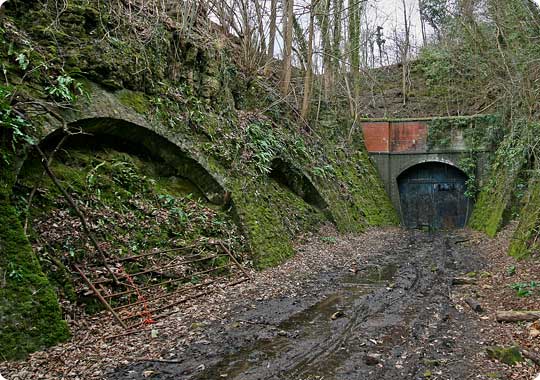
Colour photos: Four by Three
The sustainable transport charity – which seems to effortlessly wrap itself in success – will lead the construction work, supported by co-financers Bath & North East Somerset Council as well as an energetic support group. The latter’s vision and campaigning skills proved pivotal in building the head of steam behind this enterprise.
Three years from now, a ribbon of tarmacadam will extend north from Midford over the trackbed of the deceased Somerset & Dorset Railway. The village sits to the south of Bath, beyond a limestone barrier which drives roads, river, canal, surviving railway and another Sustrans path on a circuitous seven mile slog into the city centre. Straightening curves and flattening undulations, the Two Tunnels route will slash three miles off that journey, thanks largely – you’ve guessed it – to a pair of disused tunnels.
Overlooked by Midford Viaduct is the Hope & Anchor pub – two compelling reasons for meeting up there with my tame tour guides Mark Annand and Matt Skidmore, who kindly took time out to immerse me in the engineering. Both sit on the support group’s committee although neither will be sedentary over the months to come.
Two Tunnels is immensely ambitious. Disjointed paths – lacking sensible access or a cycle-friendly surface – already occupy sections of the route. Progress is impaired by poor drainage which deters the less adventurous during wet weather. Creating a single, seamless link presents plenty of challenges: erecting two new bridges and reclaiming another over the Great Western main line; refurbishing a pair of three-arch viaducts plus a far grander affair at Tucking Mill. And let’s not forget those tunnels.
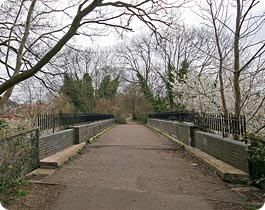
within Bath’s existing ‘linear park’.
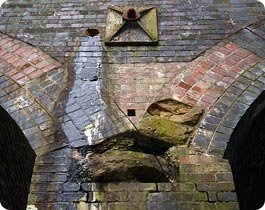
Watery Bottom Viaduct.
Conquering the formidable gradients of the Somerset & Dorset’s extension into Bath involved serious engineering, matched only by capital costs. Its opening on 20th July 1874 brought both massive traffic growth and a financial burden which the company couldn’t bear. Scarcely a year on, the Midland and London & South Western Railways jointly took charge of the line through a 999 year lease.
The S&D enjoyed a quirky life, endearing it to many. Track and signalling oddities inspired its Slow & Dirty tag. A daily Bournemouth-Manchester express was threaded between freight and local passenger services whilst summer Saturdays brought a procession of holiday trains ferrying northerners to the exotic south coast.
Like two others, the section from Bath Junction to Midford remained single line until the plug was pulled in March 1966. Tucking Mill Viaduct – now barricaded at each end – was widened to accommodate two but never did. For the past 16 years it has been owned by the Monumental Trust Company which has vanished without trace. In the absence of a watchful custodian, the structure succumbed to vandalism and the blight of vegetation – if left unchecked, its future would be threatened. Attention is high on the project’s to-do list. Mysteriously, the deck was recently cleared by persons unknown but ivy continues to overwhelm three of its seven brick piers. Roots also make their presence felt.
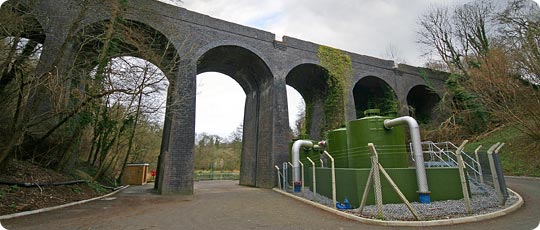
During the Seventies, a mile-long ‘linear park’ was established at the Bath end of the formation. To reduce liabilities, rail-over-road bridges were consigned to history including the viaduct over Lower Bristol Road. Replacing the smaller structures will maintain the separation of path and highway. The S&D’s crossing of Brunel’s Great Western – still in the hands of Network Rail – is also being pressed into service. The missing viaduct spawns a thorny problem which, initially at least, will be overcome by controlled crossings at existing traffic lights. Not ideal, but that’s pragmatism for you.
Having left Bath, trains battled the tortuous 1 in 50 gradient towards Devonshire Tunnel, noted for its ridiculously tight clearances – less than a foot in some cases. Today the northern approach cutting is lost beneath fill from an adjacent embankment, the full load of which is held back by a reinforced blockwall. The condition of the portal should become clear over the summer when an exhumation takes place, allowing any remedial works to be scoped.
Passing locomotives blasted clean the crown of Devonshire’s soot-encrusted lining. The rest of it will be attacked with air jets. The history of this 447 yard tunnel is unblemished, having benefited since closure from regular inspections by British Railways Board (Residuary) and its predecessors.
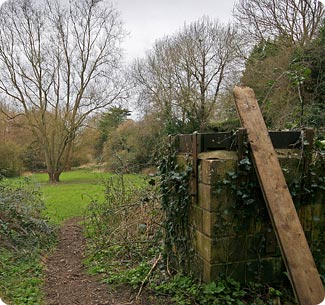
In the seclusion of Lyncombe Vale – a rural retreat within the confines of the city – an existing right-of-way occupies the trackbed as it climbs over two pint-sized viaducts. Inspections have revealed Watery Bottom to be in need of some attention. Thanks to a Two Ronnies scriptwriter for that sentence. Then, at the route’s summit, its centrepiece emerges from the undergrowth.
At a little over one mile, Combe Down is the country’s longest railway tunnel without intermediate ventilation. This caused no end of headaches during its operational life.
3.25pm on 20th November 1929. A northbound freight consisting of 37 wagons and a brake van pulled out of Midford, hauled by a 7F travelling tender first. It was still crawling as it encountered Combe Down’s gloom. The restricted bore conspired with smoke and fumes to overcome the footplate crew.
The train gathered pace as it enjoyed the falling gradient through Lyncombe Vale and Devonshire Tunnel, finally leaving the tracks at the entrance to Bath Goods Yard. By then its speed was catastrophic. Two employees on the ground were struck and killed by flying debris; the driver too surrendered to his injuries. Colonel Trench, the investigating officer, recommended that maximum loads should be reduced or assisting engines provided.
Geologically, the tunnel is a fascinating structure. Hugely appropriate then that the father of that science, William Smith, made his home at nearby Tucking Mill. It burrows 400 feet beneath Combe Down, a hill which is largely formed of oolite. Towards the southern end, it breaks through into the Midford Sands whilst, above it, a layer of Fuller’s Earth acts as a waterproofing course. The straight, central section is unlined except for occasional collars of blue brick, thought to be relics of maintenance work around the turn of the last century.
Although our National Cycle Network boasts over a dozen former railway tunnels, none of them remotely approaches the length of Combe Down. It’s very much pushing the boundaries of what’s considered practical or desirable. Curves at either end extinguish any semblance of daylight. So what about personal security? Who in their right mind would choose to spend 20 minutes shuffling through a black hole?
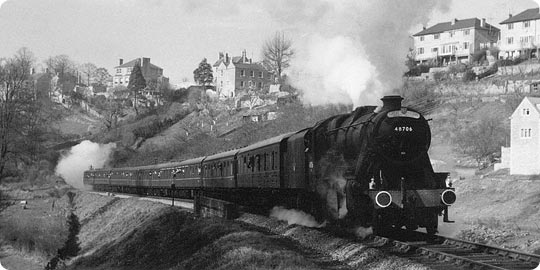
Railway Society special leaves Devonshire Tunnel behind.
Photo: John Yeo
Research suggests that people look upon disused railway tunnels in a different way to their local subway. They often become a trip’s highlight – the honeypot attraction. Anyone planning mischief immediately restricts their chances of fleeing the scene. Entrances lend themselves to discreet CCTV.
And plans are afoot to keep explorers occupied as they journey through. Combe Down has a unique character with a variety of linings and profiles. These will be lit sympathetically. Elsewhere motion detectors could trigger changes to a spectacular lighting system. There is even talk of a live display board being sited in one of the refuges, keeping travellers up-to-date on departures from Bath station. Big ideas abound.
Once open, Two Tunnels will encourage 3.8 million annual day-trippers to experience more of what Bath has to offer. In a city known for its stone – much of it mined from above the tunnel – there are few opportunities to see it in its natural home. Enter Combe Down. History points and sculptures will line the route, reflecting the S&D’s history. There’ll be something for everyone – pedestrian or cyclist; local or visitor; commuter or leisure user; young or old. The map of Bath’s attractions is going to need reprinting.
“We’ll make Two Tunnels more popular than Bath Abbey” declares John Grimshaw, Sustrans’ irrepressible Chief Executive who soon retires to manage the project. “This will become the tourist site for the West Country. It’s going to be a challenge.”
And that, ladies and gentlemen, is a master of understatement at work.
More Information
| Two Tunnels Greenway | Main project website |
| Yahoo Supporters Group | Why not sign up and give your support to the project? |
| Connect2 | Sustrans page highlighting the community benefits |
| Two Tunnels Project | Support page from Bath & North East Somerset Council |






